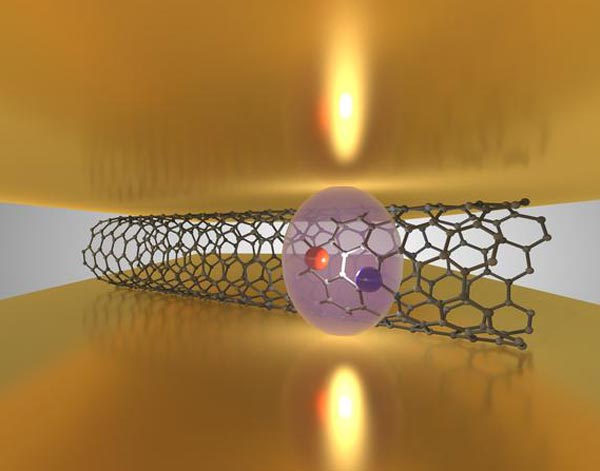Carbon Nanotubes Couple Light and Matter

The formation of exciton-polaritons through strong light-matter coupling is a promising strategy for producing electrically pumped carbon-based lasers. Scientists from Heidelberg University and the University of St Andrews (Scotland) have now, for the first time, demonstrated this strong light-matter coupling in semiconducting carbon nanotubes. Figure: Arko Graf (Heidelberg University)
With their research on nanomaterials for optoelectronics, scientists from Heidelberg University and the University of St Andrews (Scotland) have succeeded for the first time to demonstrate a strong interaction of light and matter in semiconducting carbon nanotubes.
Such strong light-matter coupling is an important step towards realising new light sources, such as electrically pumped lasers based on organic semiconductors. They would be, amongst other things, important for applications in telecommunications. These results are the outcome of a cooperation between Prof. Dr Jana Zaumseil (Heidelberg) and Prof. Dr Malte Gather (St Andrews), and have been published in “Nature Communications”.
Organic semiconductors based on carbon are a cost and energy-efficient alternative to conventional inorganic semiconductors such as silicon. Light-emitting diodes consisting of these materials are already ubiquitously found in smartphone displays.
Further components for application in lighting technology, data transmission and photovoltaics are currently at the prototype stage. So far, however, it has not been possible to produce one important component of optoelectronics with organic materials – the electrically pumped laser. The main reason is that organic semiconductors have only limited capacity for charge transport.
Prof. Zaumseil explains that research over the past few years has increasingly focused on laser-like light emission of organic semiconductors based on light-matter coupling. If photons (light) and excitons (matter) are brought to interact sufficiently, they couple so strongly that they produce so called exciton-polaritons.
These are quasi-particles that also emit light. Under certain conditions, such emissions can take on the properties of laser light. Combined with sufficiently fast charge transport, exciton-polaritons could bring the production of an electrically pumped carbon-based laser within reach, according to Jana Zaumseil who is the head of the Nanomaterials for Optoelectronics research group at the Heidelberg University's Institute for Physical Chemistry.
Thanks to the cooperation between Prof. Zaumseil and Prof. Gather, it was possible for the first time to demonstrate the formation of exciton-polaritons in semiconducting carbon nanotubes. Unlike other organic semiconductors, these microscopically small, tube-shaped carbon structures transport positive and negative charges extremely well.
PhD student Arko Graf, the first author of the study, explains that exciton-polaritons also display extraordinary optical properties. The scientists in Heidelberg and St Andrews see their research results as an important step towards realising electrically pumped lasers on the basis of organic semiconductors.
Prof. Zaumseil emphasises: “Besides the potential generation of laser light, exciton-polaritons already allow us to vary the wavelength of the light emitted by the carbon nanotubes over a wide range in the near-infrared.”
Original publication:
A. Graf, L. Tropf, Y. Zakharko, J. Zaumseil and M. C. Gather: Near-infrared exciton-polaritons in strongly coupled single-walled carbon nanotube microcavities. Nature Communications 7, 13078 (published online 10 October 2016), doi: 10.1038/ncomms13078
Contact:
Prof. Dr Jana Zaumseil
Institute for Physical Chemistry
Phone +49 6221 54-5065
zaumseil@uni-heidelberg.de
Communications and Marketing
Press Office, phone +49 6221 54-2311
presse@rektorat.uni-heidelberg.de
http://www.pci.uni-heidelberg.de/apc/zaumseil/index.html
https://gatherlab.wp.st-andrews.ac.uk
Media Contact
All latest news from the category: Physics and Astronomy
This area deals with the fundamental laws and building blocks of nature and how they interact, the properties and the behavior of matter, and research into space and time and their structures.
innovations-report provides in-depth reports and articles on subjects such as astrophysics, laser technologies, nuclear, quantum, particle and solid-state physics, nanotechnologies, planetary research and findings (Mars, Venus) and developments related to the Hubble Telescope.
Newest articles

First-of-its-kind study uses remote sensing to monitor plastic debris in rivers and lakes
Remote sensing creates a cost-effective solution to monitoring plastic pollution. A first-of-its-kind study from researchers at the University of Minnesota Twin Cities shows how remote sensing can help monitor and…

Laser-based artificial neuron mimics nerve cell functions at lightning speed
With a processing speed a billion times faster than nature, chip-based laser neuron could help advance AI tasks such as pattern recognition and sequence prediction. Researchers have developed a laser-based…

Optimising the processing of plastic waste
Just one look in the yellow bin reveals a colourful jumble of different types of plastic. However, the purer and more uniform plastic waste is, the easier it is to…


